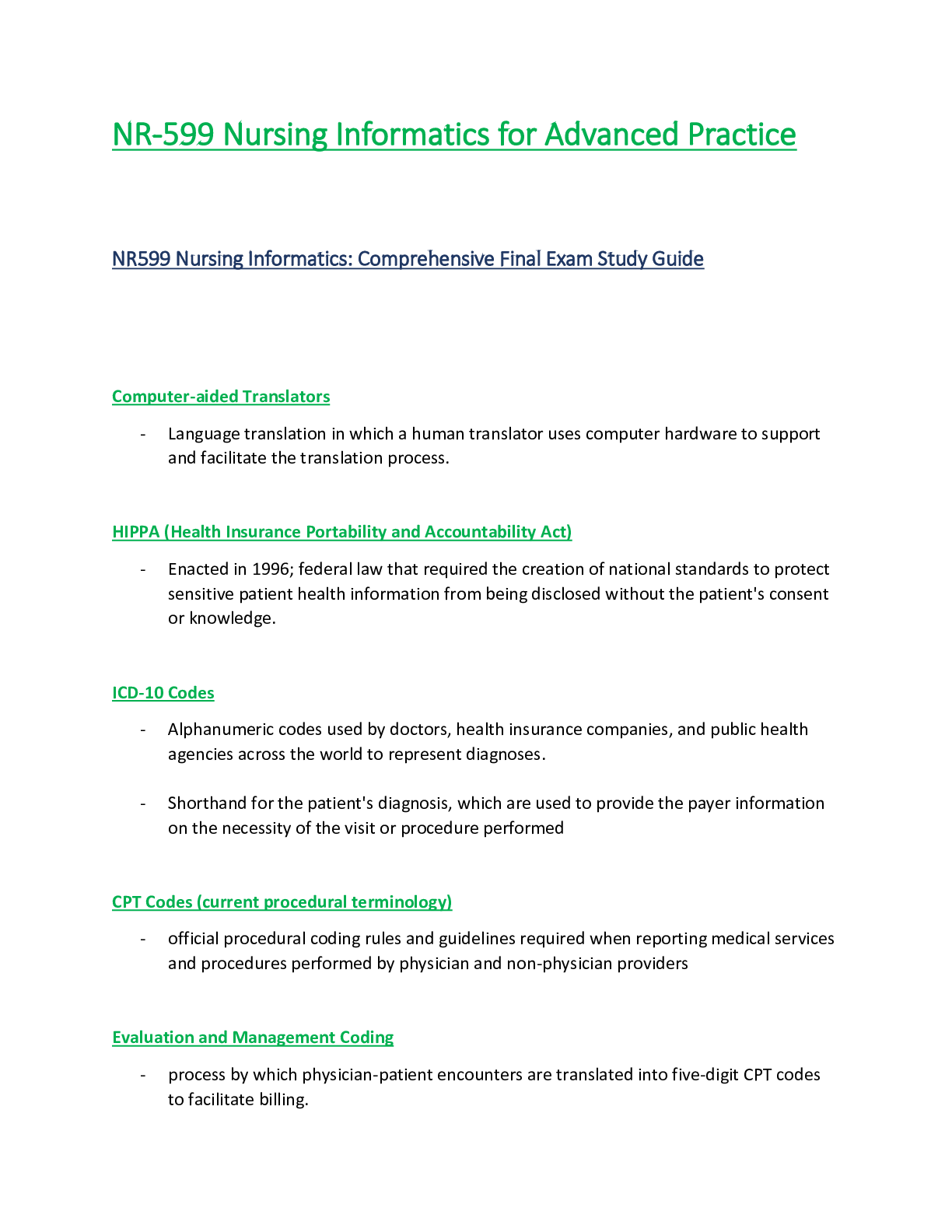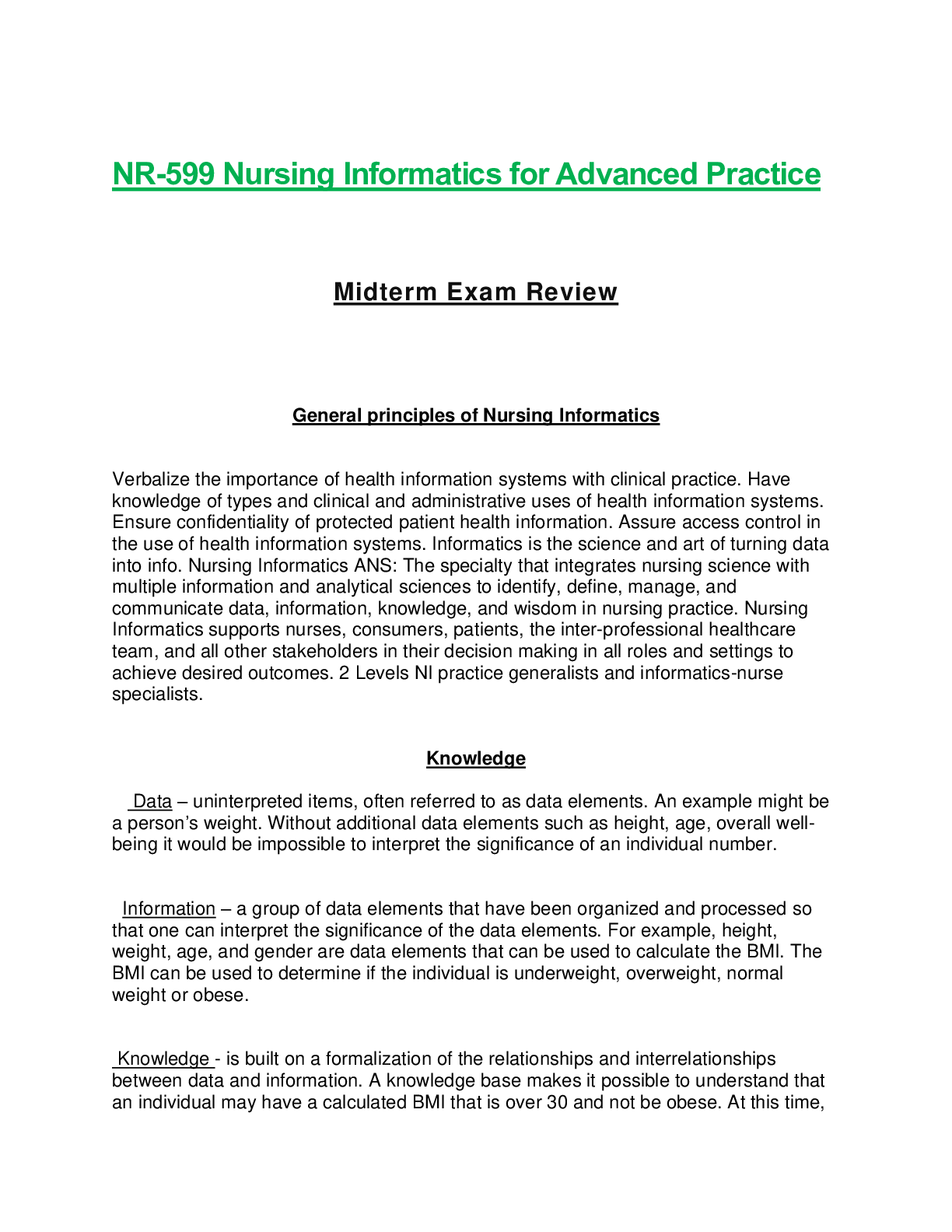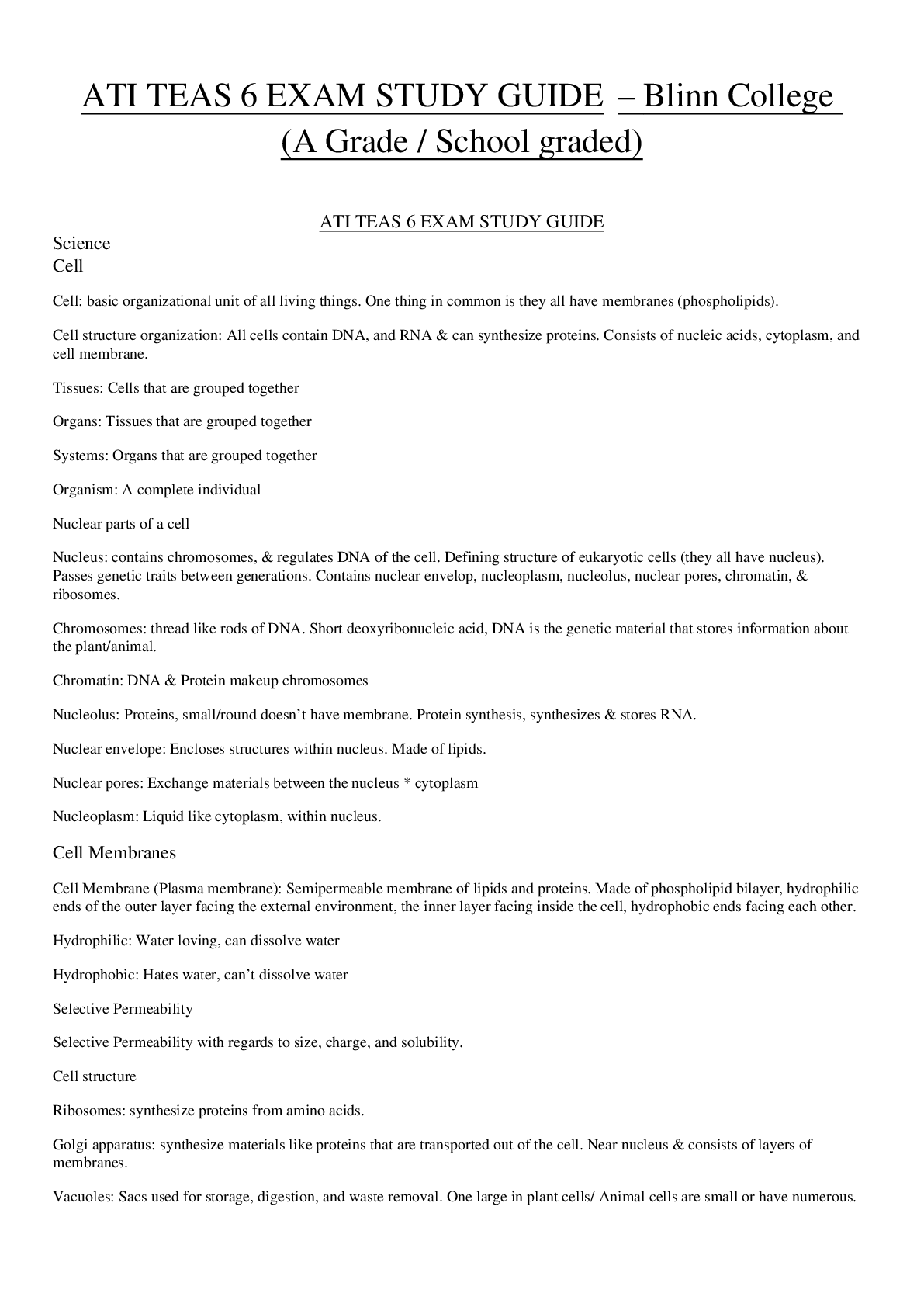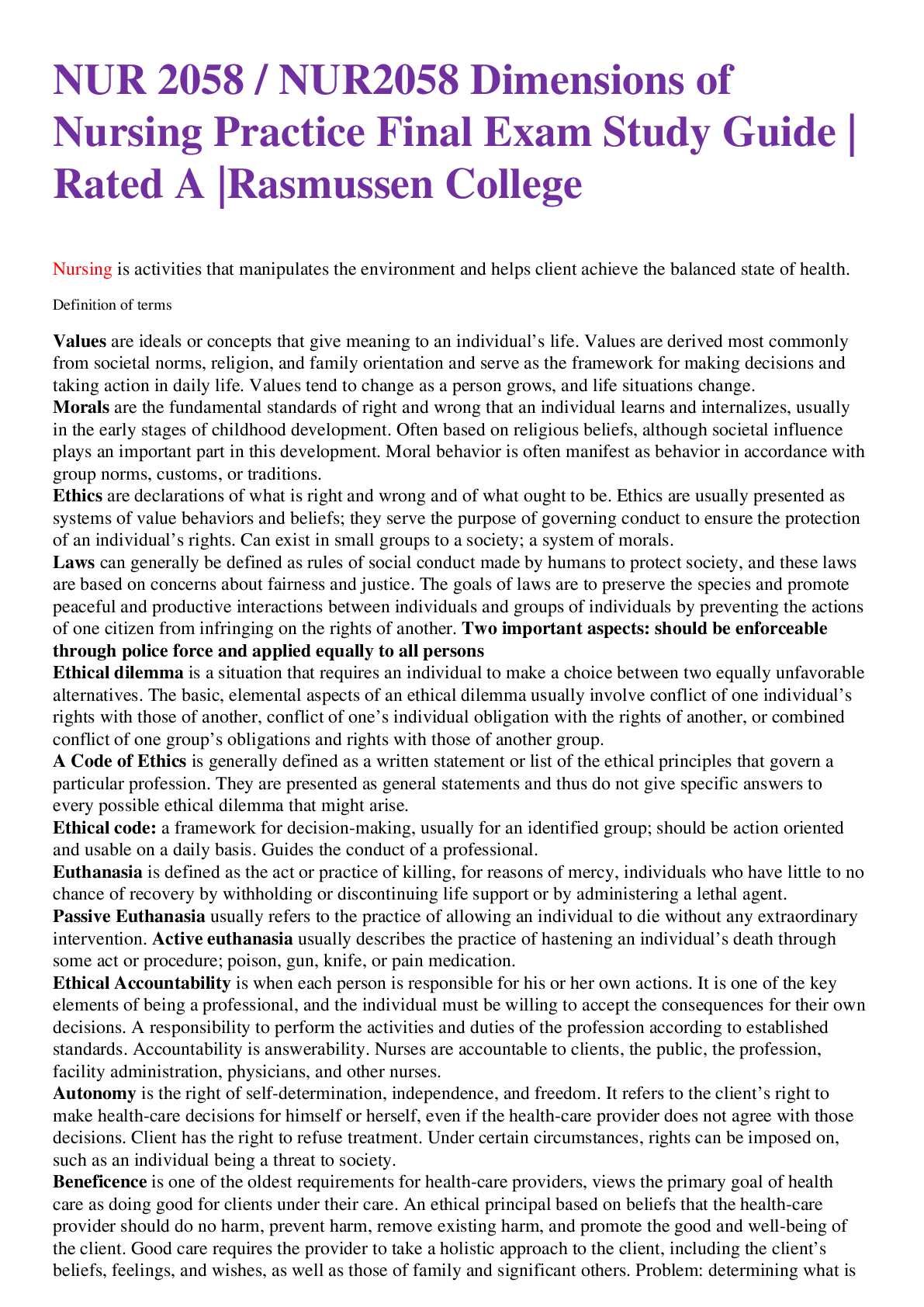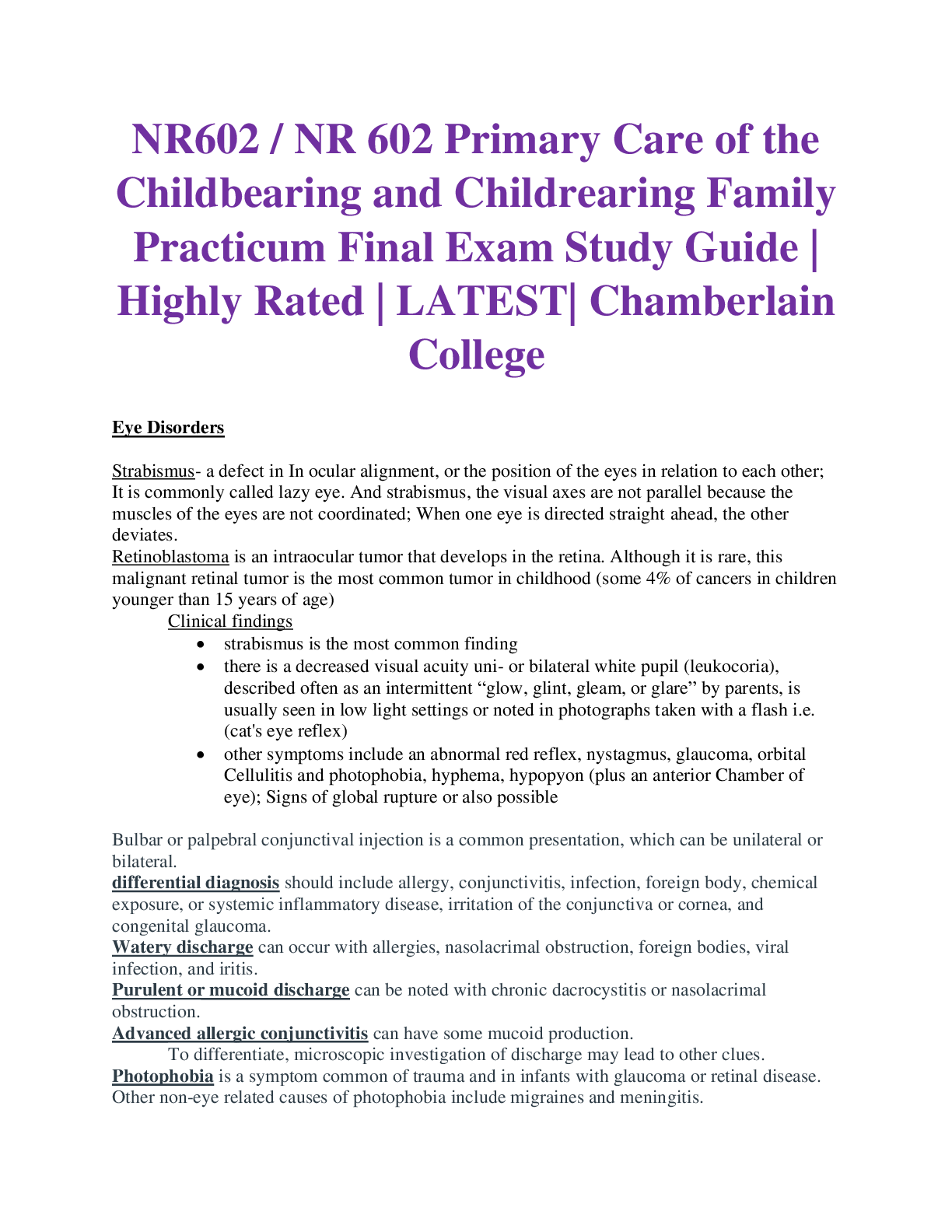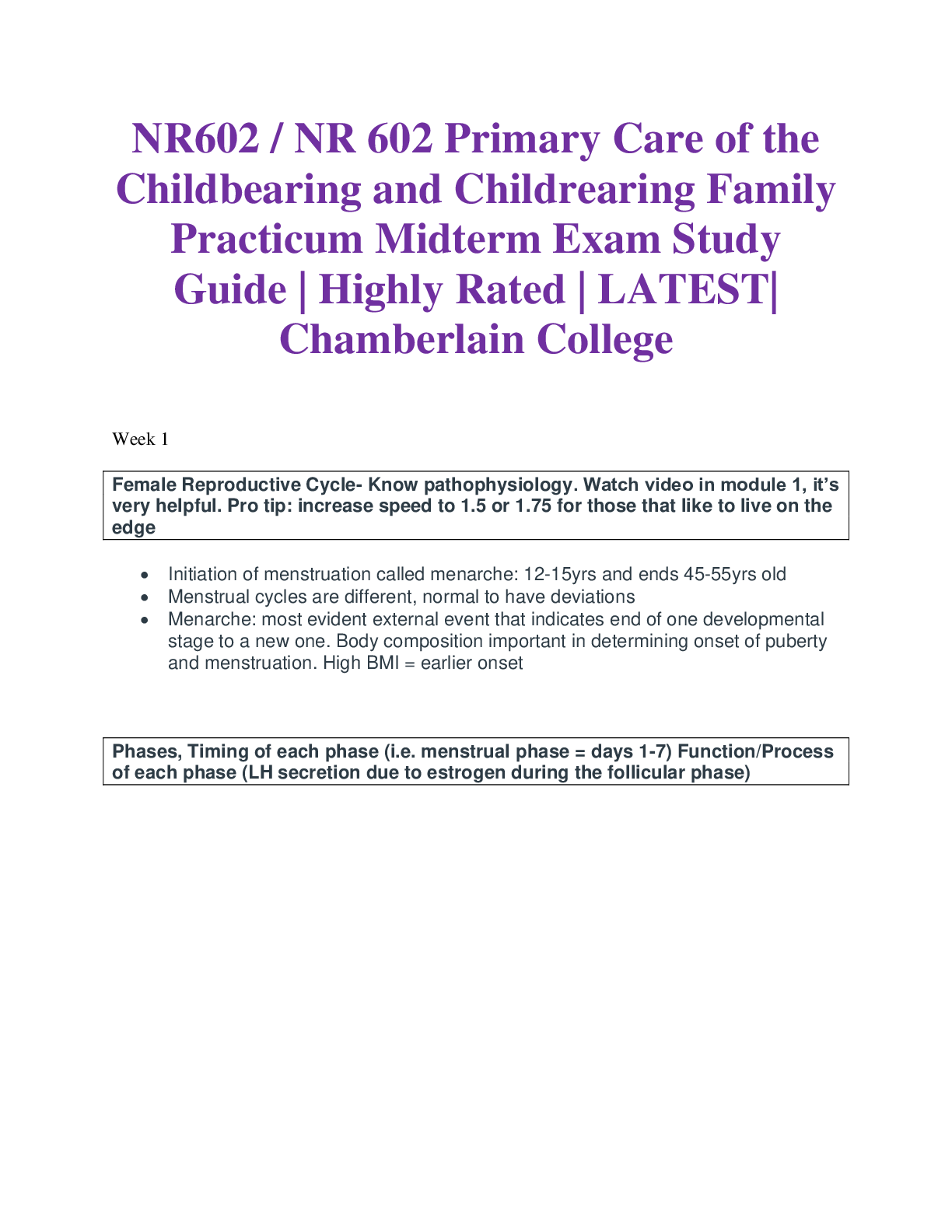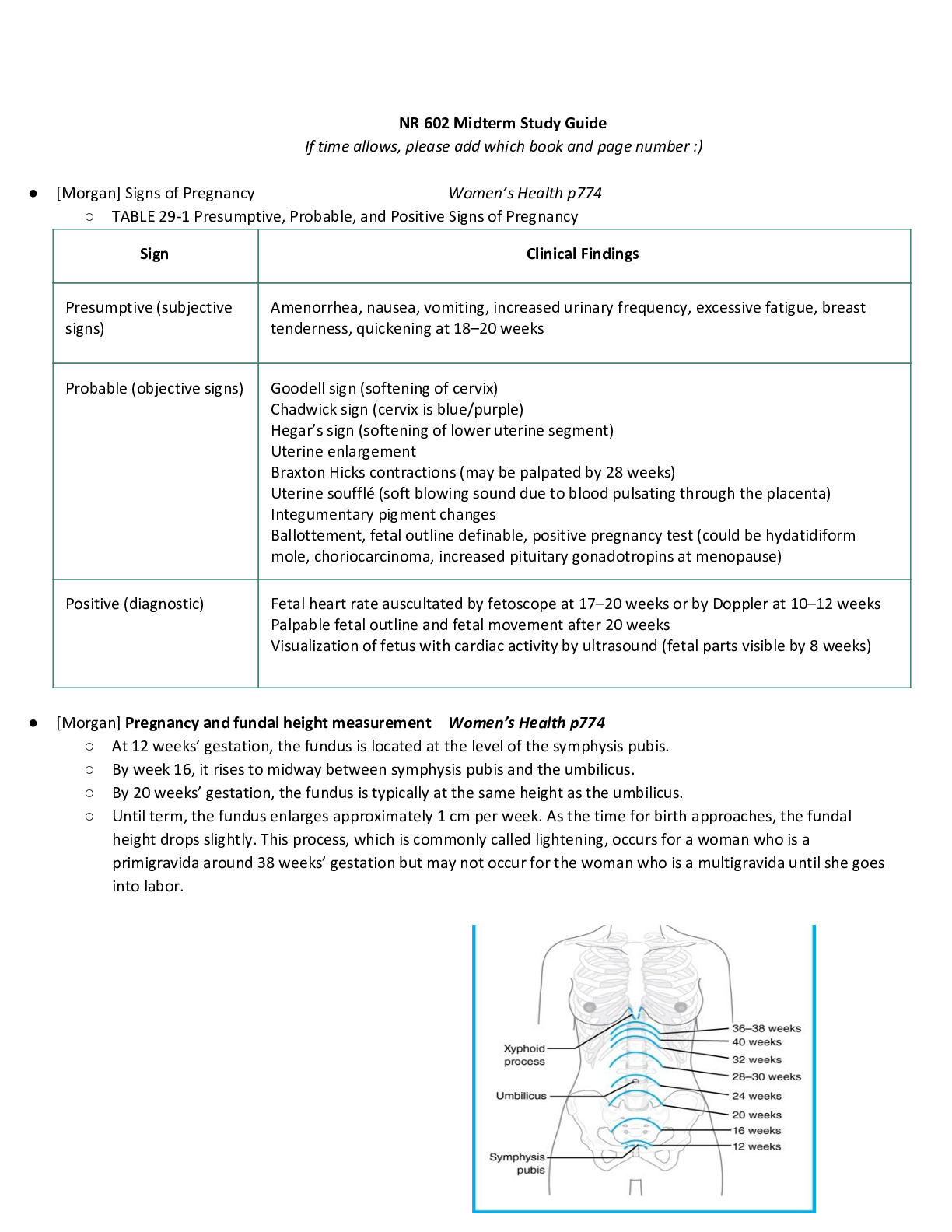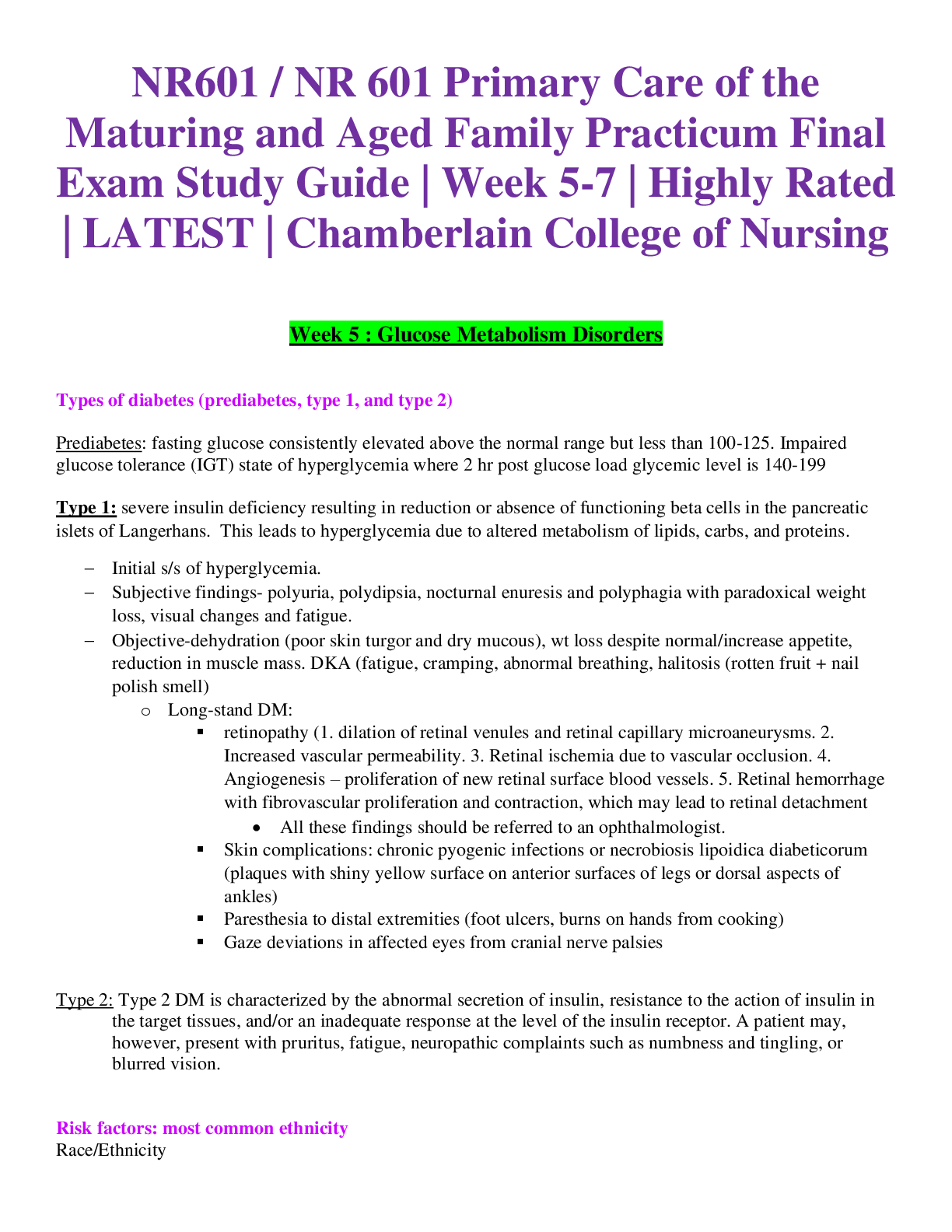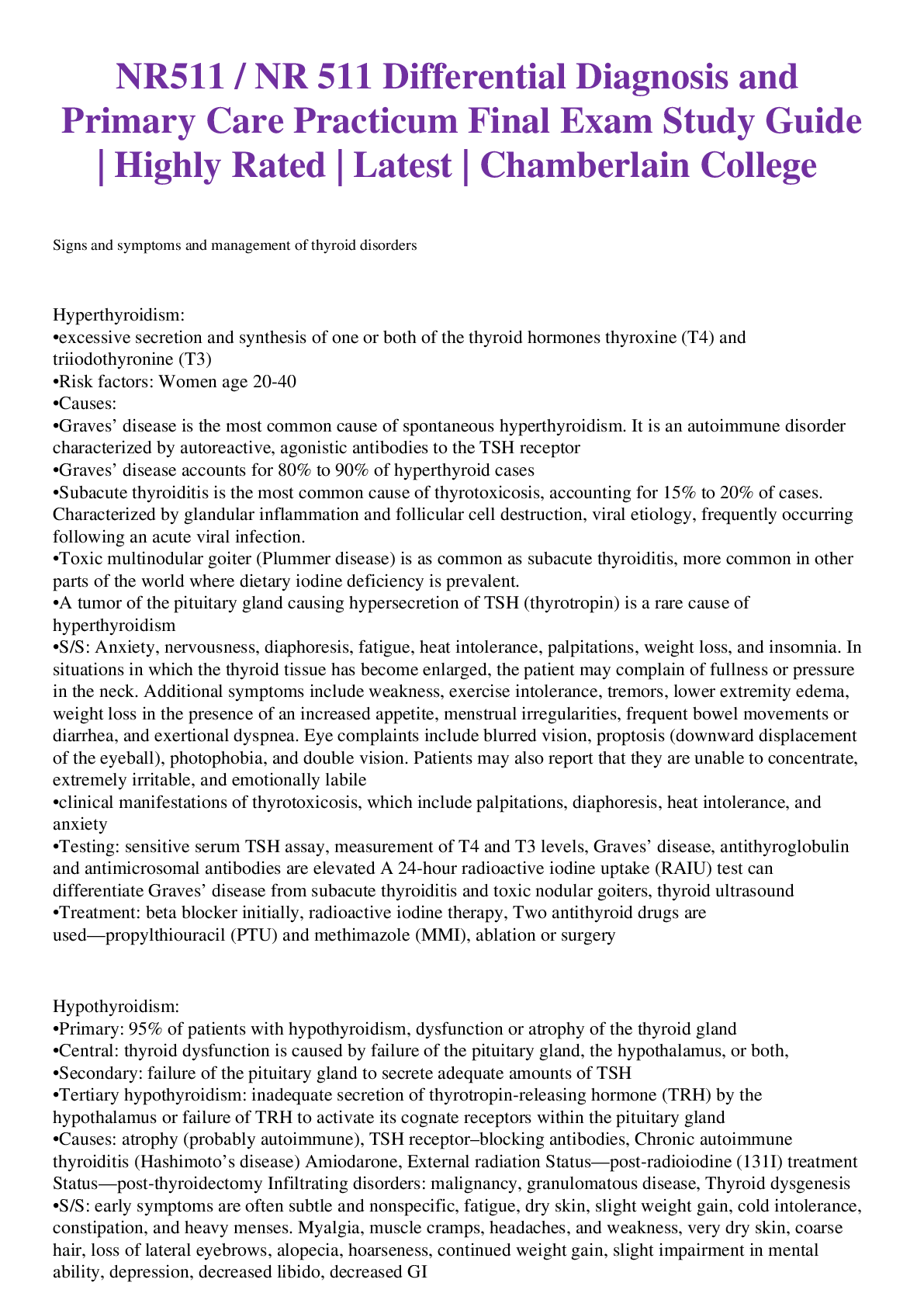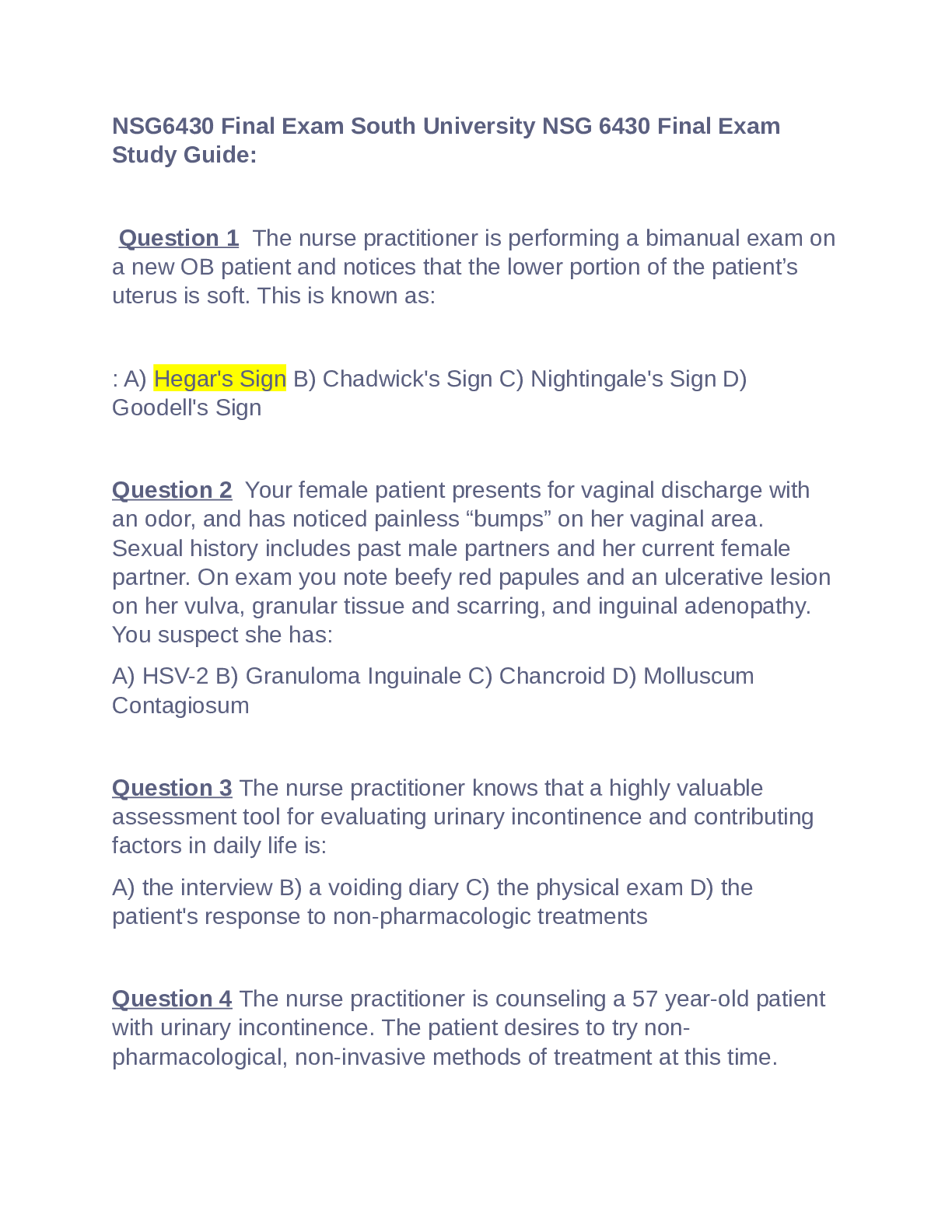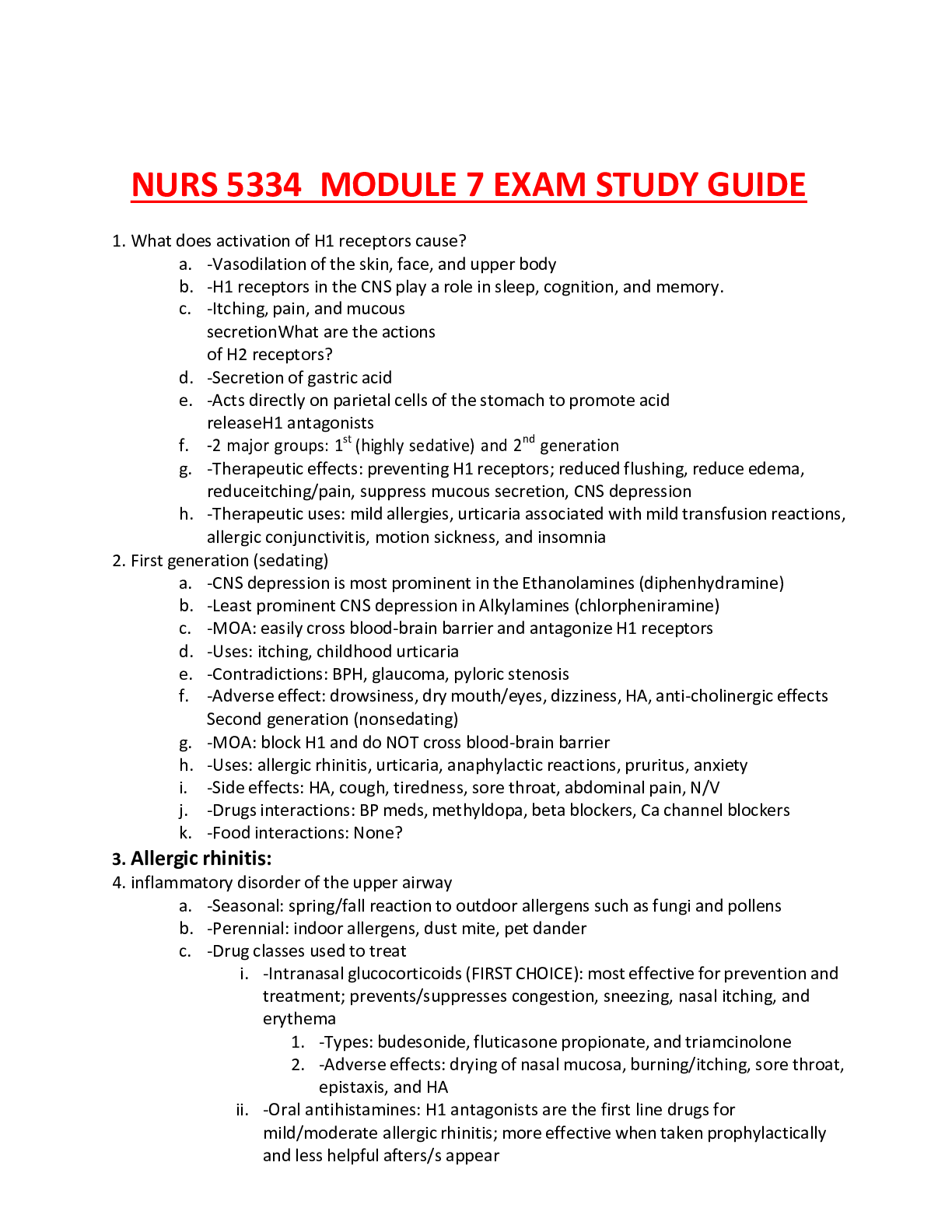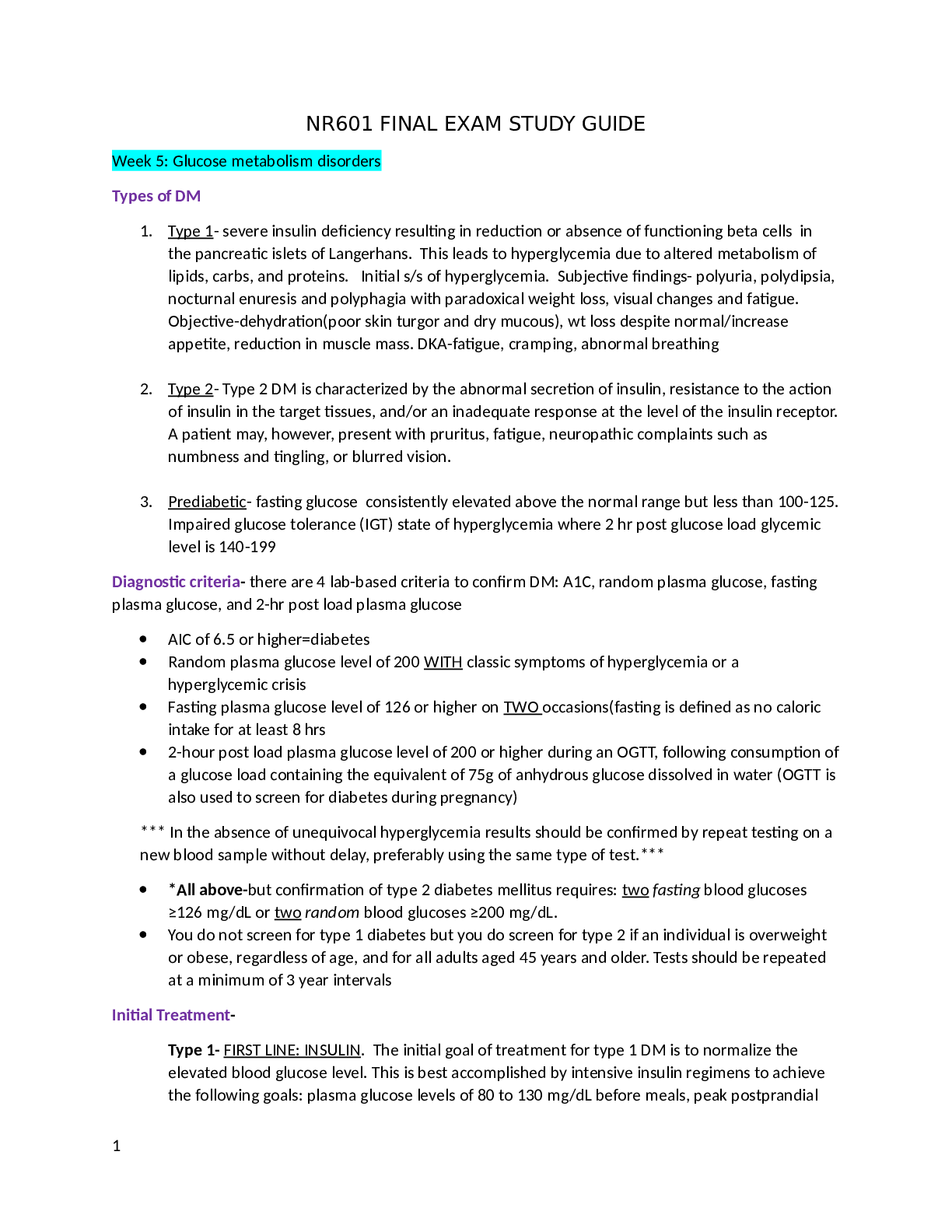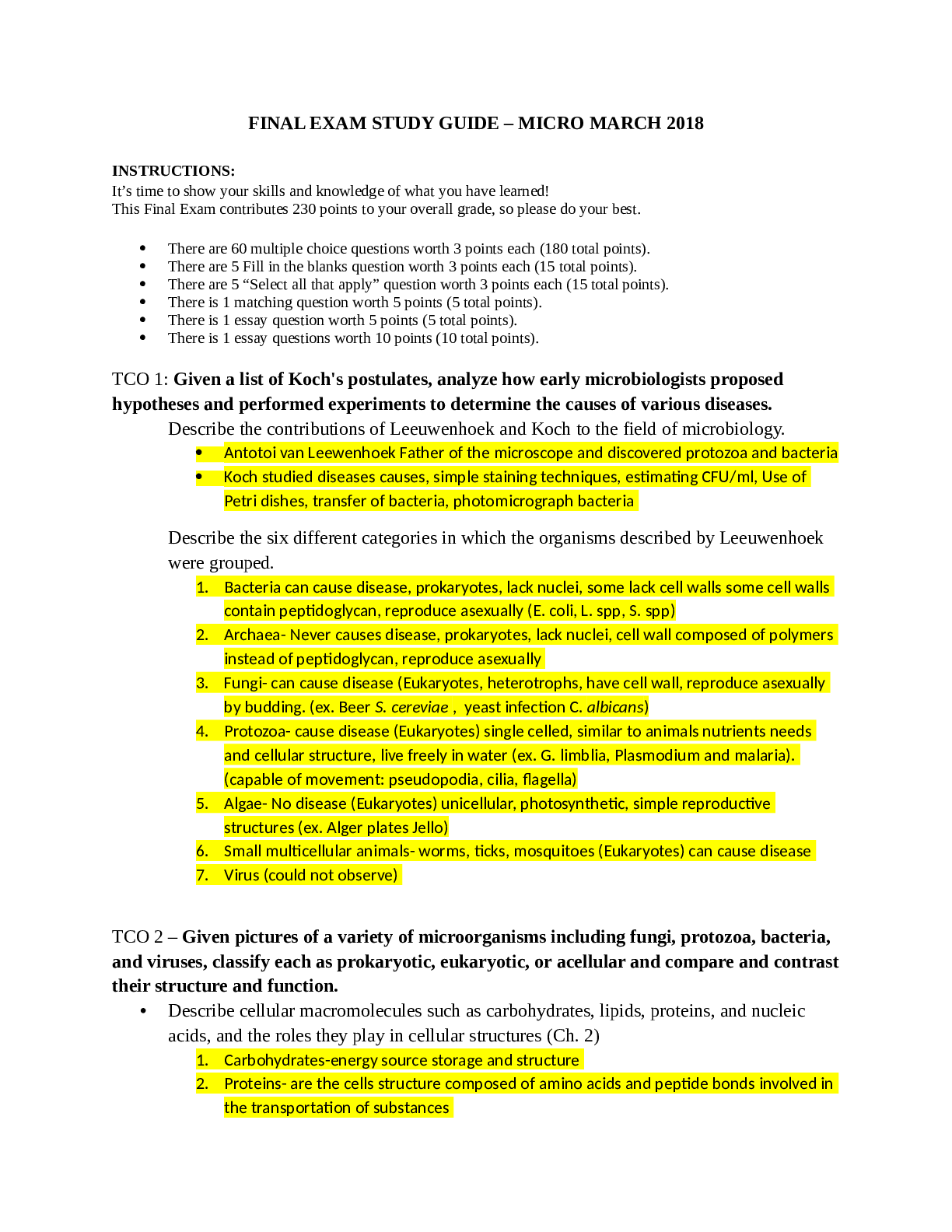*NURSING > STUDY GUIDE > NR 507 Week 8 Final Exam Study Guide | Download To Score An A (All)
NR 507 Week 8 Final Exam Study Guide | Download To Score An A
Document Content and Description Below
This study guide is for the comprehensive final exam that will be given during Week 8. Remember that you have until Saturday of Week 8, 11:59 p.m. MT to complete the final exam. Respondus Lockdown Bro... wser is used for all quizzes and exams. It will cover the following concepts: NR 507 Week 8 Final Study Guide (Variant 1) Reproductive: Endometrial cycle (menstrual cycle) and the occurrence of ovulation Uterine prolapse Polycystic ovarian syndrome Testicular cancer and conditions that increase risk Symptoms that require evaluation for breast cancer Signs of premenstrual dysphoric disorder Dysfunctional uterine bleeding Pathophysiology of prostate cancer HPV and the development of cervical cancer Endocrine: Body’s process for adapting to high hormone levels Cushing’s Syndrome Causes of hypoparathyroidism Lab results that point to primary hypothyroidism Pathophysiology of thyroid storm Signs of thyrotoxicosis Neurological: Dermatomes Substance release at the synapse Spondylolysis Location of the motor and sensory areas of the brain Pathophysiology of cerebral infarction Excitotoxins Agnosia Accumulation of blood in a subarachnoid hemorrhage Most common cause of meningitis Genitourinary: Diet and the prevention of prostate cancer Impact of Benign Prostatic Hypertrophy (BPH) on the urinary system Genetics: The role of DNA in genetics Transcription Effects of genetic mutations Trisomy Down Syndrome Klinefelter syndrome Diseases that have multifactorial traits Multifactorial inheritance Duchenne muscular dystrophy Neurofibromatosis Musculoskeletal: Ions that initiate muscle contraction Growth of long bones in children Bones belonging to the appendicular skeleton Immunity/Inflammation: How vaccines are formed Populations at risk for getting systemic fungal infections and parasitic infections Systemic manifestations of infection Mechanisms responsible for the increase in antimicrobial resistance worldwide Functions of normal flora in the body Desensitization therapy Cells involved in “left shift” in the WBC count differential Forms of immunity Major histocompatibility class I antigens Inflammatory chemicals blocked by anti-inflammatory drugs Characteristics of acute phase reactant C-reactive protein Dermatology: Process by which a deep pressure ulcer heals Complications of the development of contractures during wound healing Acid/Base: Causes of respiratory alkalosis Molecules that act as buffers in the blood Cardiovascular: Most common cardiac valve disease in women When myocardial ischemia may be reversible Symptoms of stable angina Orthostatic hypotension Isolated systolic hypertension Results of sustained controlled hypertension The relationship of insulin resistance on the development of primary hypertension Defects in the normal secretion of natriuretic hormones and the impact on renal system Effects of increased sympathetic nervous system activity due to primary hypertension Complications of unstable plaque in the coronary arteries Forms of dyslipidemia associated with the development of the fatty streak in atherosclerosis Events that initiate the process of atherosclerosis Signs and symptoms of increased left atrial and pulmonary venous pressures in left sided heart failure Differences between left and right sided heart failure Infective endocarditis Peripheral vascular disease: Pathophysiology of deep vein thrombosis Virchow’s triad Hematology: Physiological response to hypoxia in anemia Populations at the highest risk for developing folate deficiency anemia Causes of iron deficiency anemia Expected lab test results found in long standing iron deficiency anemia Sickle Cell Anemia Causes of aplastic anemia Underlying pathophysiologic mechanisms leading to autoimmune hemolytic anemia Secondary polycythemia Anemia of chronic renal failure Fluid and Electrolytes: Conditions that result in pure water deficit (hypertonic volume depletion) Osmoreceptors that stimulate thirst and the release of ADH Causes of hypernatremia Effects of increased aldosterone Dependent edema Definition of isotonic Principle of capillary oncotic pressure Types of fluid compartments in the body Pulmonary: Most effective measure to prevent pulmonary embolus from developing in patients When the practitioner will note tactile fremitus Cause of acute airway obstruction in the patient with chronic bronchitis Types of pneumothorax Results of the loss of alph-1-antitrypsin in emphysema The result of loss of surfactant in ARDS Characteristics of Cheyne-Stokes respirations Shock: Causes of hypovolemic shock How the body maintains glucose levels during shock NR 507 Week 8 Final Study Guide (Variant 2) Genitourinary: BPH: Prostate Cancer: Shock: Blood Glucose: Hypovolemic Shock: Acid/Base Balance: Respiratory Alkalosis: Buffer in Blood: Peripheral Vascular Disease: DVT Pathophysiology: Dermatology: Contractures: Deep Pressure Ulcer Healing: Phase 1: inflammation … proliferation and new tissue formation (reconstruction) Phase 3: remodeling and maturation Musculoskeletal: Contraction: Growth of Long Bones in Children: Bones in Appendicular Skeleton: Genetics: DNA in Genetics: Transcription: Effects of Genetic Mutations Trisomy: Down Syndrome: Klinefelter Syndrome: Diseases that have Multifactorial Traits: Multifactorial Inheritance: Duchenne Muscular Dystrophy: Neruofibromatosis: Endocrine: Adapting to High Hormone Levels: Signs/Symptoms of Thyrotoxicosis: Thyroid Storm: Hypothyroidism Lab Results: Hypoparathyroidism Causes: Cushing Syndrome: Neurological: Dermatomes: Agnosia: Spondylolysis: Meningitis Causes: Subarachnoid Hemorrhage: Substance Release at the Synapse: Cerebral infarction Pathophysiology: Pathophysiology of Excitotoxins: Fluids & Electrolytes: Pure Water Deficit (hypertonic volume depletion): Osmoreceptors that Stimulate Thirst and ADH Release: Causes of Hypernatremia: Effects of Increased Aldosterone Dependent Edema: Isotonic: Capillary Oncotic Pressure: Fluid Compartments: Pulmonary: PE Prevention: Airway Obstruction in Chronic Bronchitis: Emphysema: Types of Pneumothorax: Cheyne-Stokes Respirations: Loss of Surfactant in ARDS: Tactile Fremitus: Reproductive: Uterine Prolapse: Evaluate for Breast Cancer: Dysfunctional Uterine Bleeding: Polycystic Ovarian Syndrome: Signs of Premenstrual Dysphoric Disorder: Endometrial Cycle and Ovulation: Testicular Cancer Risk Factors: Pathophysiology of Prostate Cancer: HPV to Cervical Cancer: Hematology: Populations at Risk for Folate Deficiency Anemia: Causes of Iron Deficiency Anemia: Lab Results for Long Standing Iron Deficiency Anemia: Causes of Aplastic Anemia: Secondary Polycythemia: Autoimmune Hemolytic Anemia: Sickle Cell Anemia: Anemia of Chronic Renal Failure: Physiologic Response to Hypoxia in Anemia: Cardiovascular: Most Common Valve Disease in Women: Myocardial Ischemia: Symptoms of Stable Angina: Orthostatic Hypotension: Isolated Systolic HTN: Insulin Resistance and HTN: Natriuretic Hormones and Effects on Renal System: SNS and Primary HTN: Complications of Unstable Plaques: Process of Atherosclerosis Initiation: S/S of L Sided HF: Results of Sustained Controlled HTN: Difference in L and R sided HF: Dyslipidemia Associated with Formation of Fatty Streak: Infective Endocarditis: Immunity/Inflammation: How Vaccines are Formed: Systemic Manifestations of Infection: Functions of Normal Flora: Mechanism for Antimicrobial Resistance: Desensitization Therapy: Cells Involved in Left Shift: Forms of Immunity: Histocompatibility Class I Antigens: Chemicals Blocked by Anti-Inflammatory Drugs: C-Reactive Protein: Populations at Risk for Fungal/Parasitic Infections: NR 507 Week 8 Final Study Guide (Variant 3, 4) REPRODUCTIVE Endometrial cycle and occurrence of ovulation Uterine Prolapse PCOS Testicular cancer & Risk factors Symptoms that require evaluation for Breast Cancer Signs of premenstrual dysphoric disorder (PMDD) Dysfunctional uterine bleeding Pathophysiology of prostate cancer HPV and development of cervical cancer ENDOCRINE Body’s process for adapting to high hormone levels: Cushing’s Syndrome: Hypoparathyroidism CX: Lab results point to primary hypothyroidism: Primary hypothyroidism DX: Pathophysiology of thyroid storm: Signs of thyrotoxicosis: NEURO Dermatomes Substance release at synapse Spondylolysis Location of motor and sensory areas of the brain GENITOURINARY Diet and prevention of prostate cancer Impact of BPH on the Urinary System GENETICS The role of DNA in genetics Transcription Effects of genetic mutations – Down syndrome/ Trisomy: Klinefelter syndrome: Duchenne muscular dystrophy Neurofibromatosis diseases that have multifactorial traits/multifactorial inheritance What is multifactorial inheritance? MUSCULOSKELETAL Ions that initiate muscle contraction: Growth of long bones in children: Bones belonging to the appendicular skeleton: IMMUNITY How vaccines are performed Populations are risk for getting systematic fungal infections and parasitic infections Systematic manifestations of infection Mechanism responsible for the increase in antimicrobial resistance worldwide Functions of normal body flora Desensitization therapy Cells involved in the “left shift” in the WBC count differential Forms of Immunity Major histocompatibility class (MHC) I antigens (7th Edition, pg. 233-235, 244) Inflammatory chemicals blocked by anti-inflammatory drugs (7th Edition, pg. 207) Characteristics of acute phase reactant C-reactive protein (CRP) (7th Edition, pg. 214) DERMATOLOGY Process by which a deep pressure ulcer heals: Phases of wound healing: Inflammatory-Proliferation-Maturation Complications of the development of contractures during wound healing: ACID/BASE Causes of respiratory alkalosis: Molecules that act as buffers in the blood: CARDIOVASCULAR Most common cardiac valve disease in women When myocardial ischemia may be reversible Symptoms of stable angina (angina pectoris) Orthostatic hypotension Isolated systolic HTN Sustained controlled HTN Relationship of insulin resistance on the development of primary hypertension; pg 1136. Defects in normal secretion of natriuretic hormones & impact on renal system; pg 1134 Effects of increased sympathetic nervous system activity due to primary HTN; pg 1133 Complications of unstable plaque in the coronary arteries: Forms of dyslipidemia associated with the development of the fatty streak in atherosclerosis: Events that initiate the process of atherosclerosis: S&S of Left Atrial &Pulmonary venous pressures in Left Sided HF Difference between L & R sided © failure Infective Endocarditis PERIPHERAL VASCULAR DISEASE Peripheral vascular disease: Deep Vein Thrombosis pathophysiology Vichow’s traid: HEMATOLOGY Physiological response to hypoxia in anemia Populations at highest risk for developing folate deficiency anemia Cause of Iron Deficiency Anemia Expected lab test results found in long standing Iron Deficiency Anemia Sickle Cell Anemia Aplastic Anemia Pathophysiology of Autoimmune Hemolytic Anemia Secondary polycythemia Vera Anemia of chronic renal failure FLUIDS & ELECTROLYTES Conditions that result in pure water deficit (hypertonic volume depleted) Osmoreceptors that stimulate thirst and the release of ADH Causes of hypernatremia Effects of increased aldosterone Dependent edema Definition of isotonic Principle of capillary oncotic pressure Types of fluid compartments in the body PULMONARY most effective measure to prevent pulmonary embolus from developing in patients when the practitioner will note tactile fremitus cause of acute airway obstruction in the patient with chronic bronchitis TYPES OF PNEUMOTHORAX Results of the loss of alph-1- antitrypsin in emphysema The result of loss of surfactant in ARDS Characteristics of Cheyne-Stokes respirations SHOCK Causes of hypovolemic shock (7th Edition, pg. 1672-3) How the body maintains glucose levels during shock (7th Edition, pg. 1670) NR 507 Week Five Quiz Study Guide What controls the direct stimulation of the insulin-secreting cells? Types of protein hormones –Which of the following is an example of the protein hormone? Assessing patients for elevated thyroxine production –A patient who has elevated thyroxine production should be assessed for which accompanying condition? Direct effect of insulin binding to receptors –What type of effect occurs when insulin binds to its receptors on muscle cells, resulting in an increase in glucose uptake by those muscle cells? Lipid-soluble hormone receptors crossing plasma membrane –How do lipid-soluble hormone receptors cross the plasma membrane? Effects of the removal of the posterior pituitary –How do the releasing hormones that are made in the hypothalamus travel to the anterior pituitary? –If a patient’s posterior pituitary is removed, which hormone would the nurse expect to decrease? Insulin regulation –Insulin is primarily regulated by Hormone-secreting tumor of the pancreas—what would increase? –A patient is diagnosed with a hormone-secreting tumor of the pancreas alpha cells. Which of the following would the nurse expect to be most likely increased in this patient? The effect of insulin on electrolytes –A nurse recalls insulin has an effect on which of the following groups of electrolytes? Hormonal regulation involved in child birth and stopping uterine bleeding? –A 39-year-old female is recovering from the birth of her third child. Which hormone would help prevent uterine bleeding? Types of immunity-e.g. innate, active, etc Alveolar ventilation/perfusion Dermatologic conditions e.g. pityriasis rosea Croup Types of anemia Macrocytic-normochromic anemias: Microcytic-hypochromic anemias: Normocytic-normochromic Anemias: Mnemonic for different types of anemia- The inflammatory process upon injury GI symptoms resulting in heart burn Pulmonary terminology such as dyspnea, orthopnea, etc Complications of gastric resection surgery Dermatology terminology-macules, nevi, etc Chicken pox Maternal immune system Candidiasis exacerbation Carbuncles Terms such as hypochromic, macrocytic, microcytic, etc Antibodies, IgG, IgA, etc Skin cancer Parts of the heart in terms of function, such as pericardium Congenital heart defects Urinary tract obstruction, GI symptoms of conditions such as pyloric stenosis, hiatal hernia, ulcerative colitis Skin cancer lesions Gastroesophageal reflux disease Hypersensitivity reaction Congenital intrinsic factor deficiency Acid base imbalance Acute epiglottitis Types of gastric ulcers-signs and symptoms, characteristics Lupus General adaptation syndrome Ventilation/perfusion ratio Bile salt deficiencies Clonal selection Obstructive sleep apnea Large bowel obstruction Vaginal candidiasis Folate deficiency Pancreatic insufficiency Types of fractures Genetic disorders such as Down Syndrome, Turner Syndrome, etc Vitamin B-12 therapy Glaucoma Cervical immunoglobulin Concept of pain **See pgs 485-495 Autosomal dominant diseases (ADD) pg 152-154 Congenital murmurs Lactose intolerance Angiotensin-renin system AIDS Carcinoma Hormonal regulation of calcium Neural tube defect Types of hormones-Types of hormones by structure Glycoprotein Kidney stones Type 2 diabetes Pituitary hormone secretion Signs of breast cancer- Alzheimer’s disease- Guillain-Barre Syndrome Sympathetic/parasympathetic nervous system *See pg 471-476 ACTH Bartholin glands (pg 772) Gonococcal disease (pg 920-922) Glomerulonephritis- Small patent ductus arteriosus (PDA)- Risk factors for hypertension- (HTN= >120/>80) Loss of language and/or comprehension-such as terms-aphasia, etc. –(Data Processing Deficits) Chronic inflammatory joint disease Male and female sex hormone production *See pgs 789-791 and 795-6 (male) and 776-78 (female) Endogenous antigen- Genital warts- Pancreatic enzymes- Process of muscle contraction- Cervical dysplasia- Consanguinity Nephrotic syndrome NR 507 Week 8 Final Exam Study Guide Related NR 507 Entire Coursework Weeks 1 – 8 $299.00 NR 507 Coursework Altogether Week 3 – 8 $199.00 NR 507 Discussions (Week 3, 6), Open Forum Discussions (Week 1, 2, 4, 5), Reflection (Week 8) $59.00 NR 507 Quizzes Week 2 plus Week 7 $60.00 NR 507 Disease Process Presentations Part 1, Part 2, Audio/Video Recorded Disease Process Presentation: Parkinson’s Disease $49.00 NR 507 Disease Process Presentation Part 1, Part 2, Final Week 7 Disease Process Presentation – Pathophysiology of: Cushing’s Disease $49.00 NR 507 Disease Process Presentations Part 1, Part 2, Audio/Video Recorded Disease Process Presentation – RABIES $49.00 NR 507 Disease Process Presentation Part 1, Part 2 Presentations Part 1, Part 2, Audio/Video Recorded Disease Process Presentation and Peer Review (Collection) $75.00 NR 507 Week 1 Bundle: Introduction plus Open Forum Discussion $29.00 NR 507 Week 1 Open Forum Discussion: Diabetes Insipidus $20.00 NR 507 Week 1 Open Forum Discussion: Mood Disorder $20.00 NR 507 Week 1 Open Forum Discussion: Rabies $15.00 NR 507 Week 1 Open Forum Discussion: Iron-Deficiency Anemia $20.00 NR 507 Week 1 plus [Show More]
Last updated: 1 year ago
Preview 1 out of 20 pages

Reviews( 0 )
Document information
Connected school, study & course
About the document
Uploaded On
Jan 01, 2022
Number of pages
20
Written in
Additional information
This document has been written for:
Uploaded
Jan 01, 2022
Downloads
0
Views
56



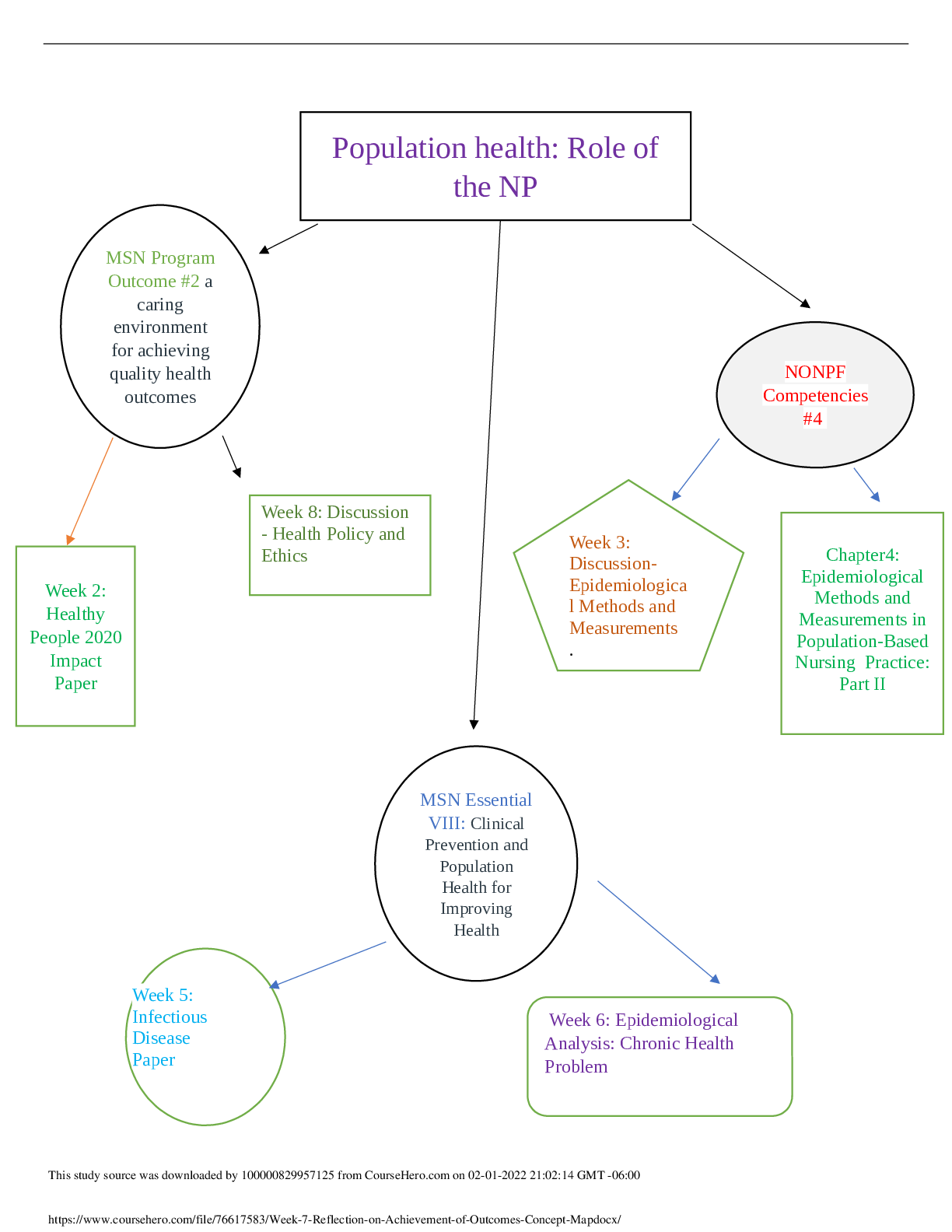


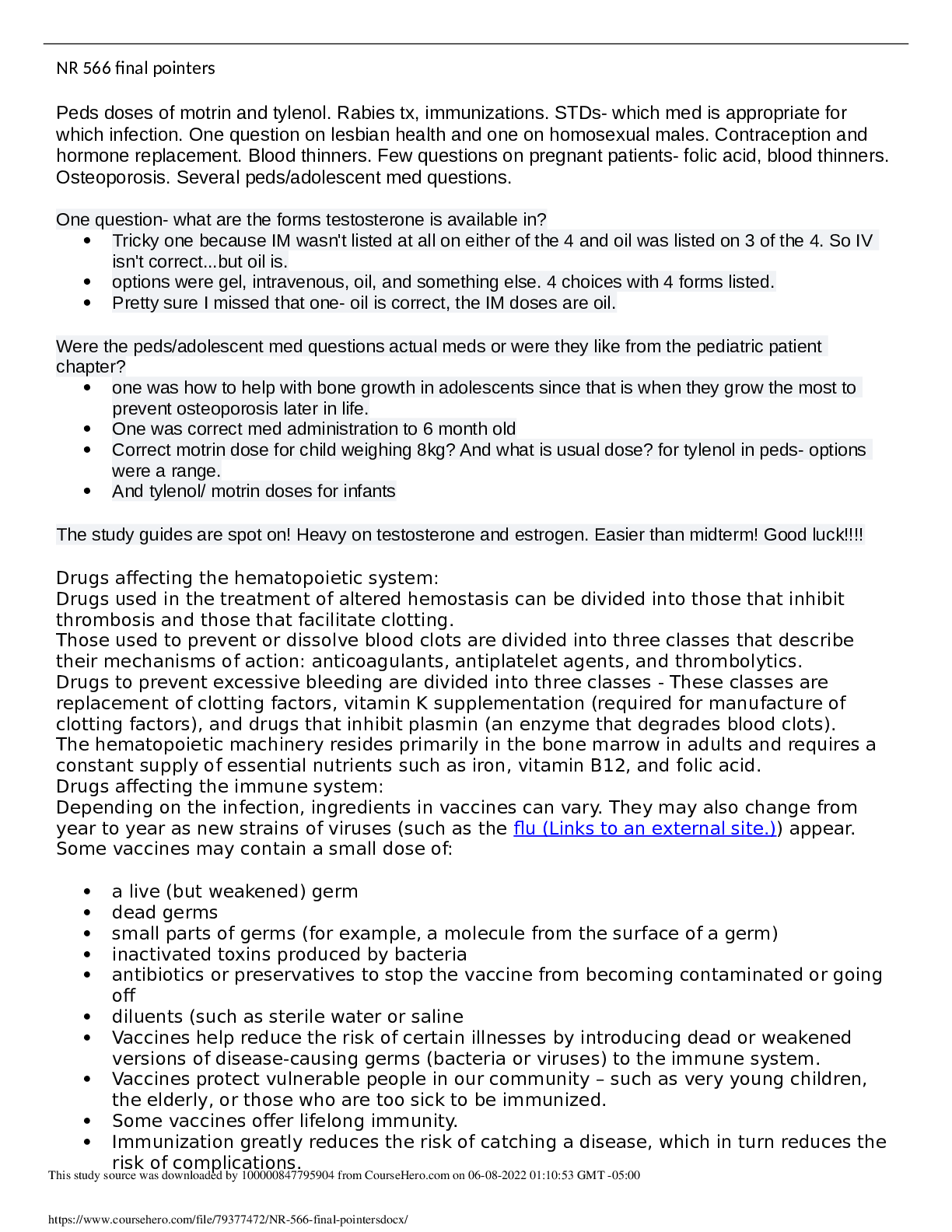
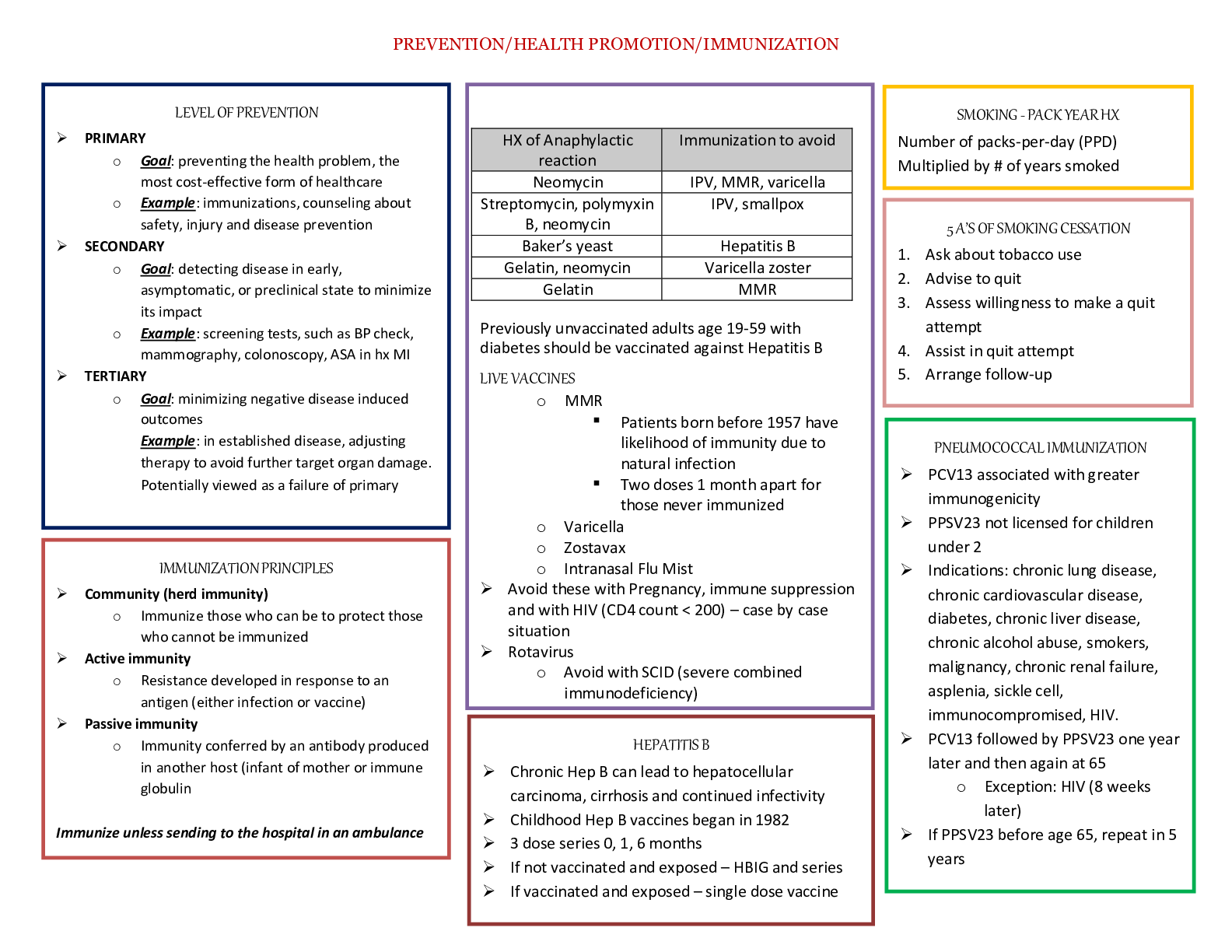
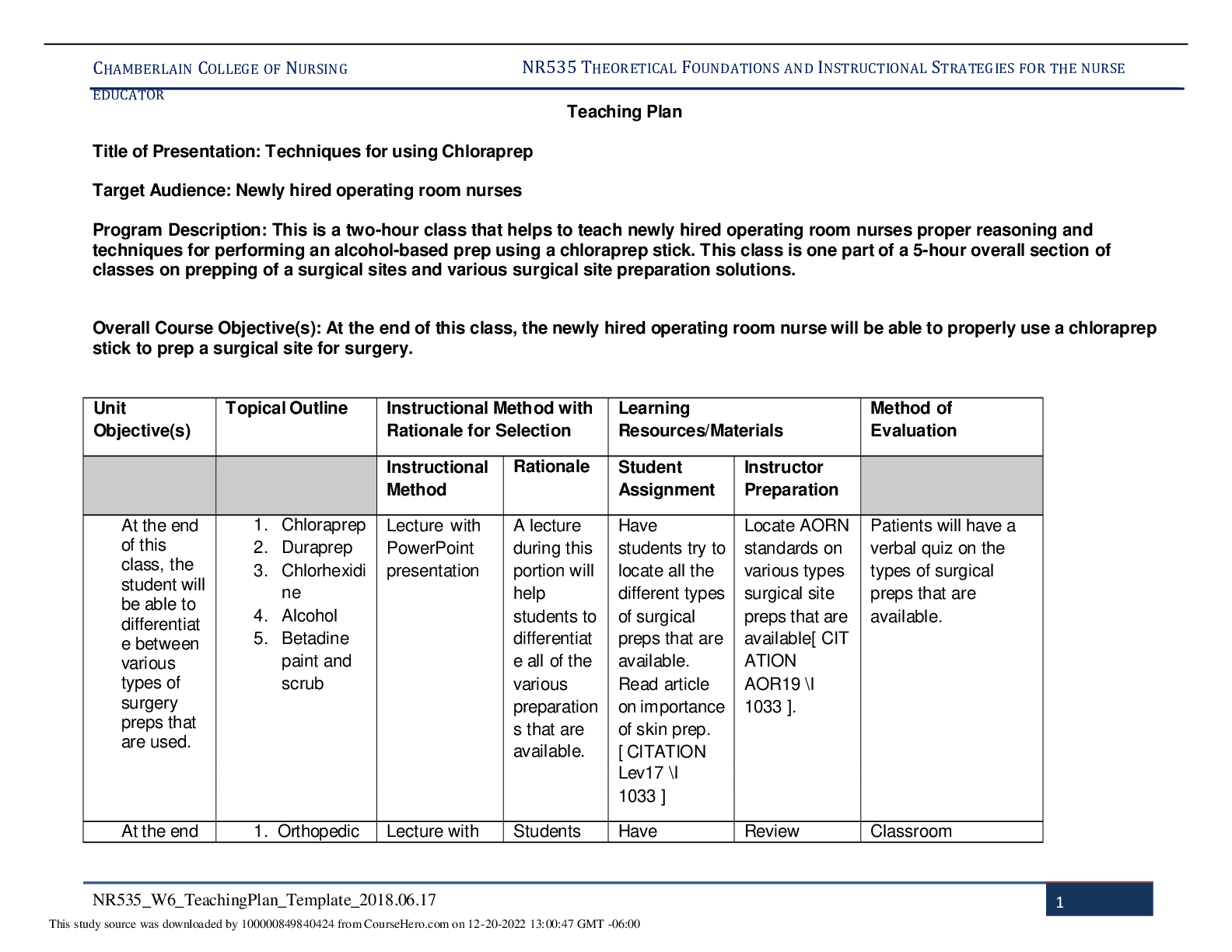

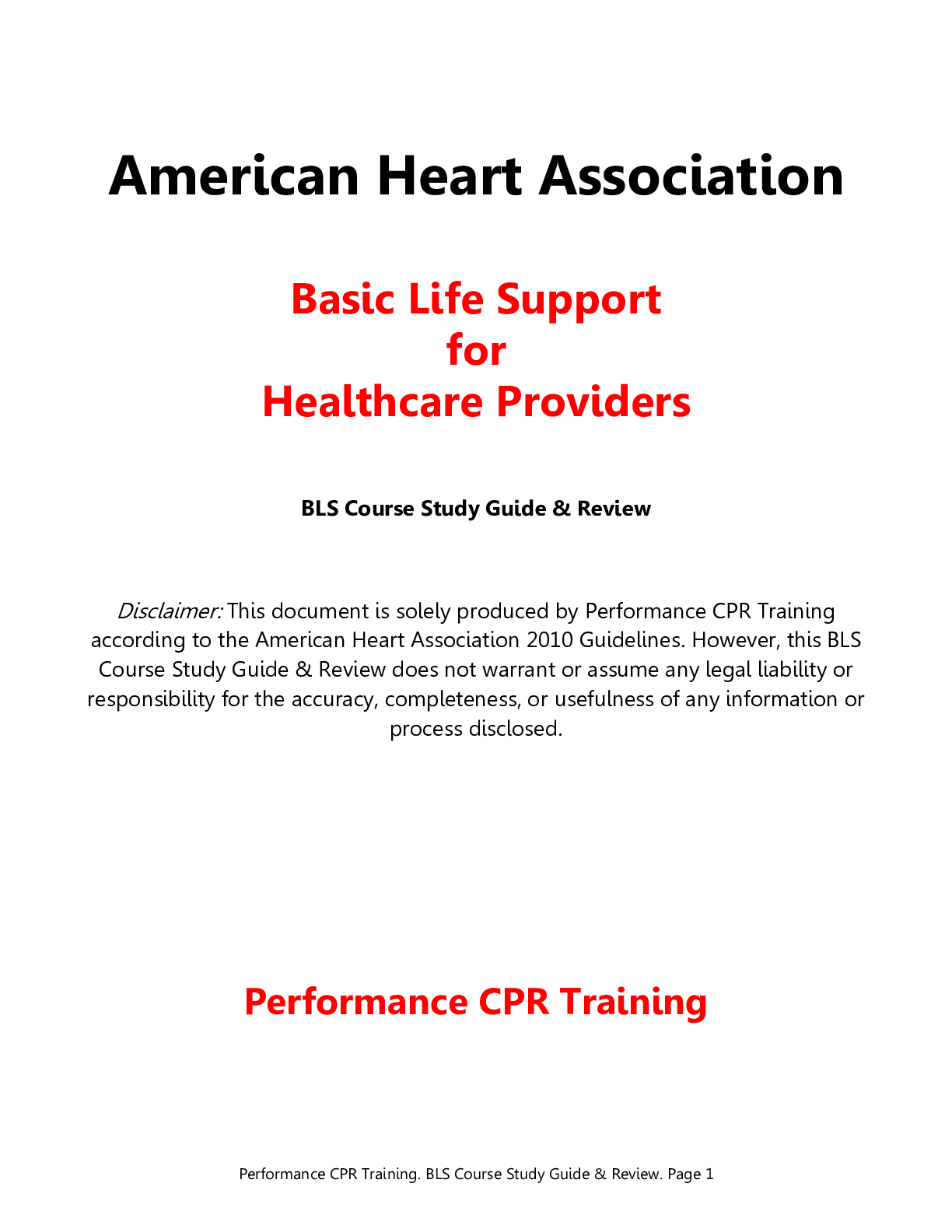
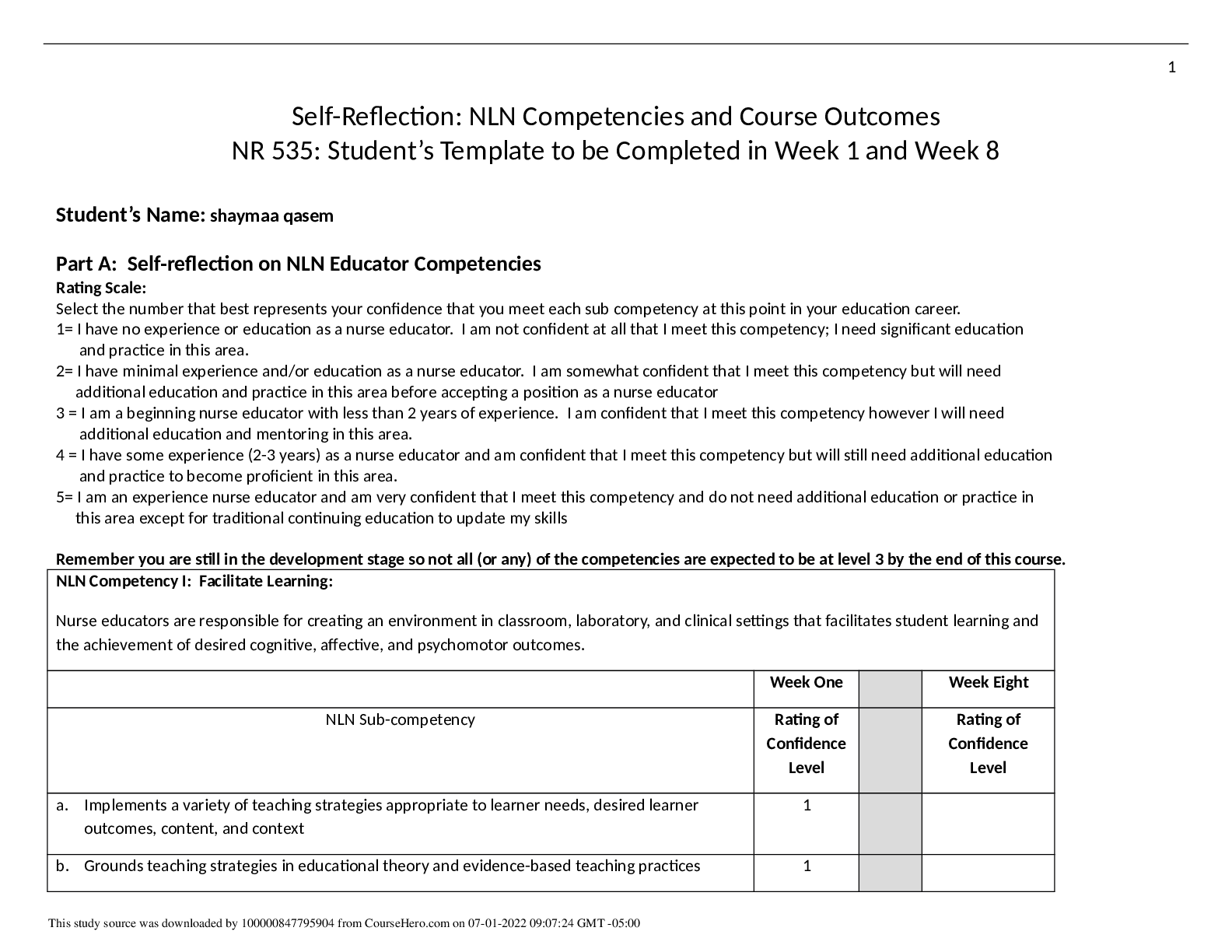
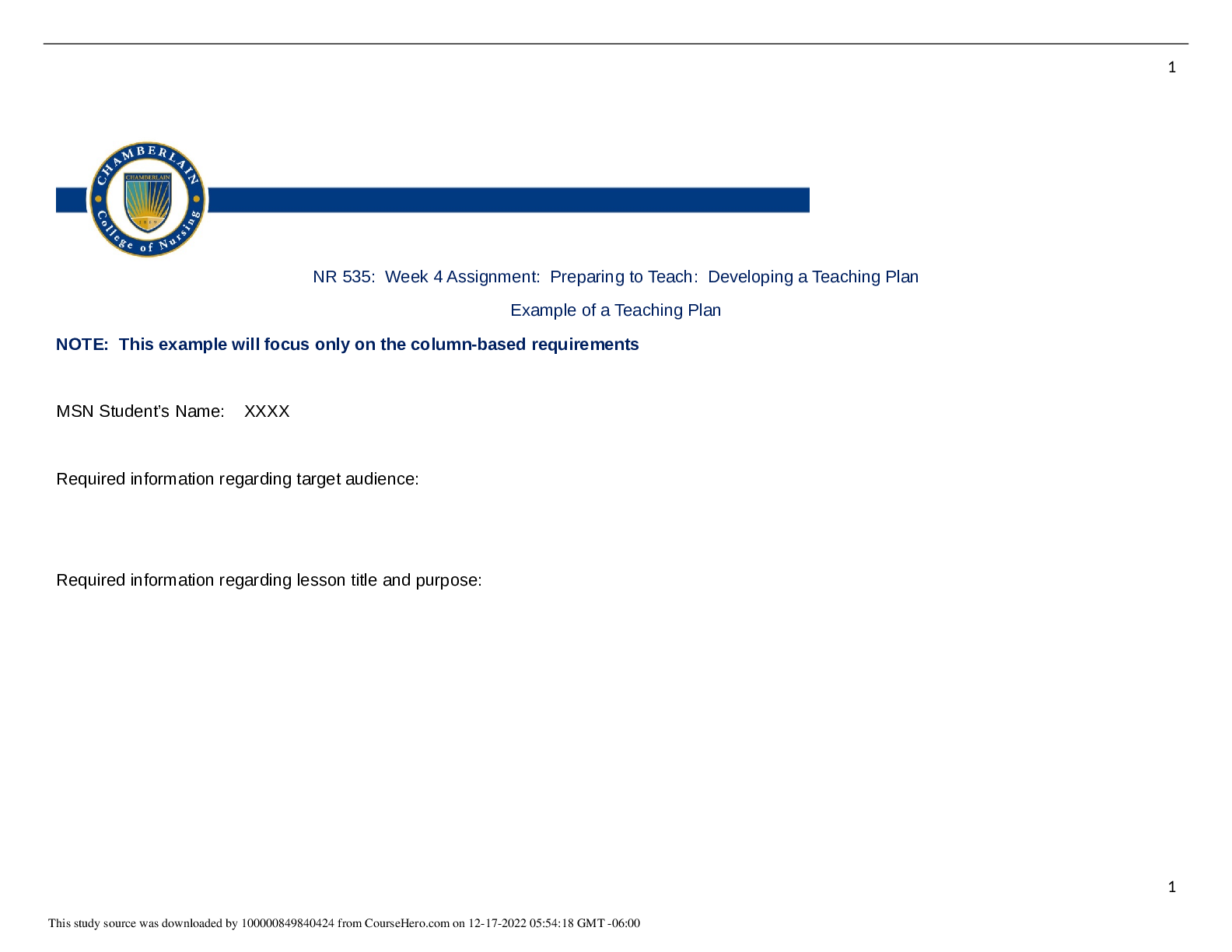
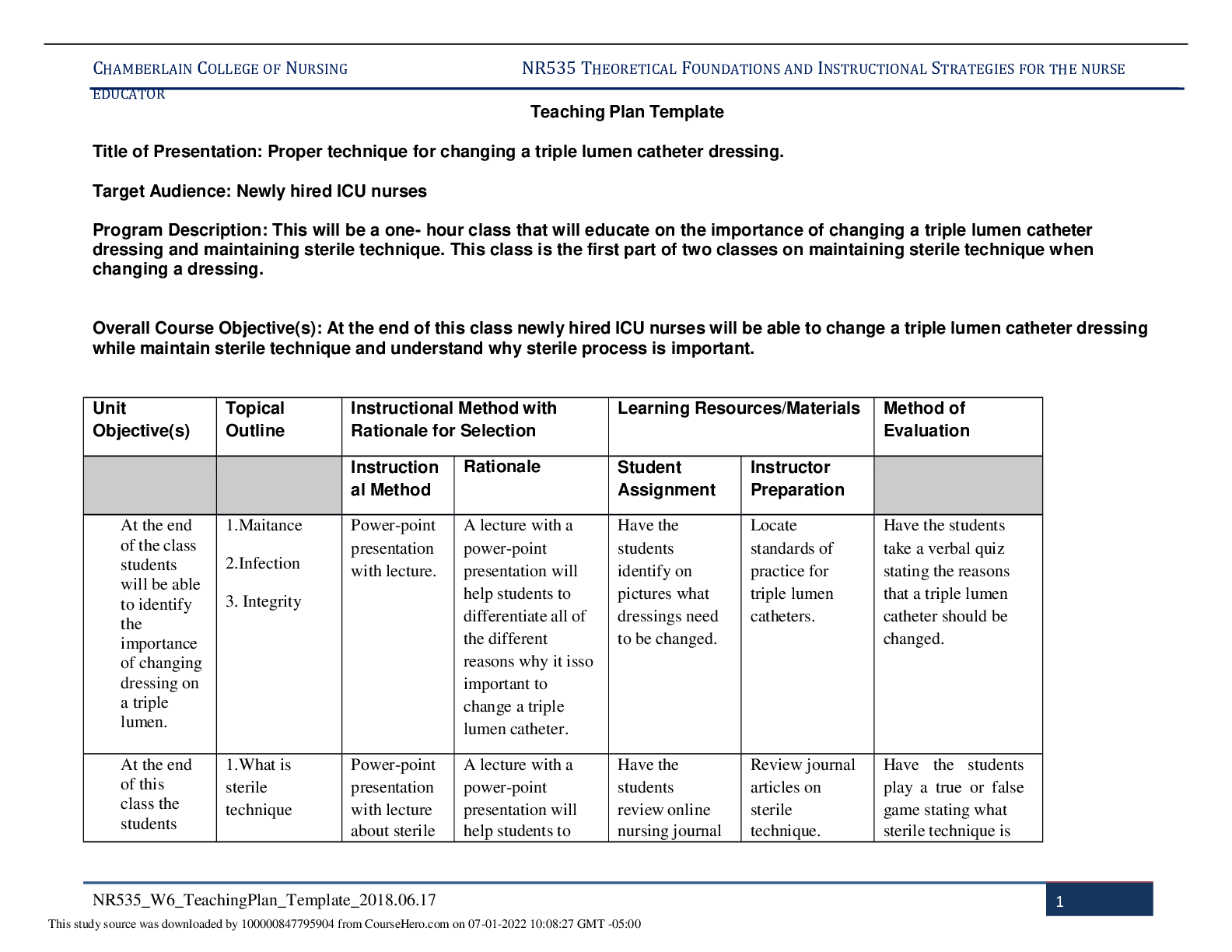
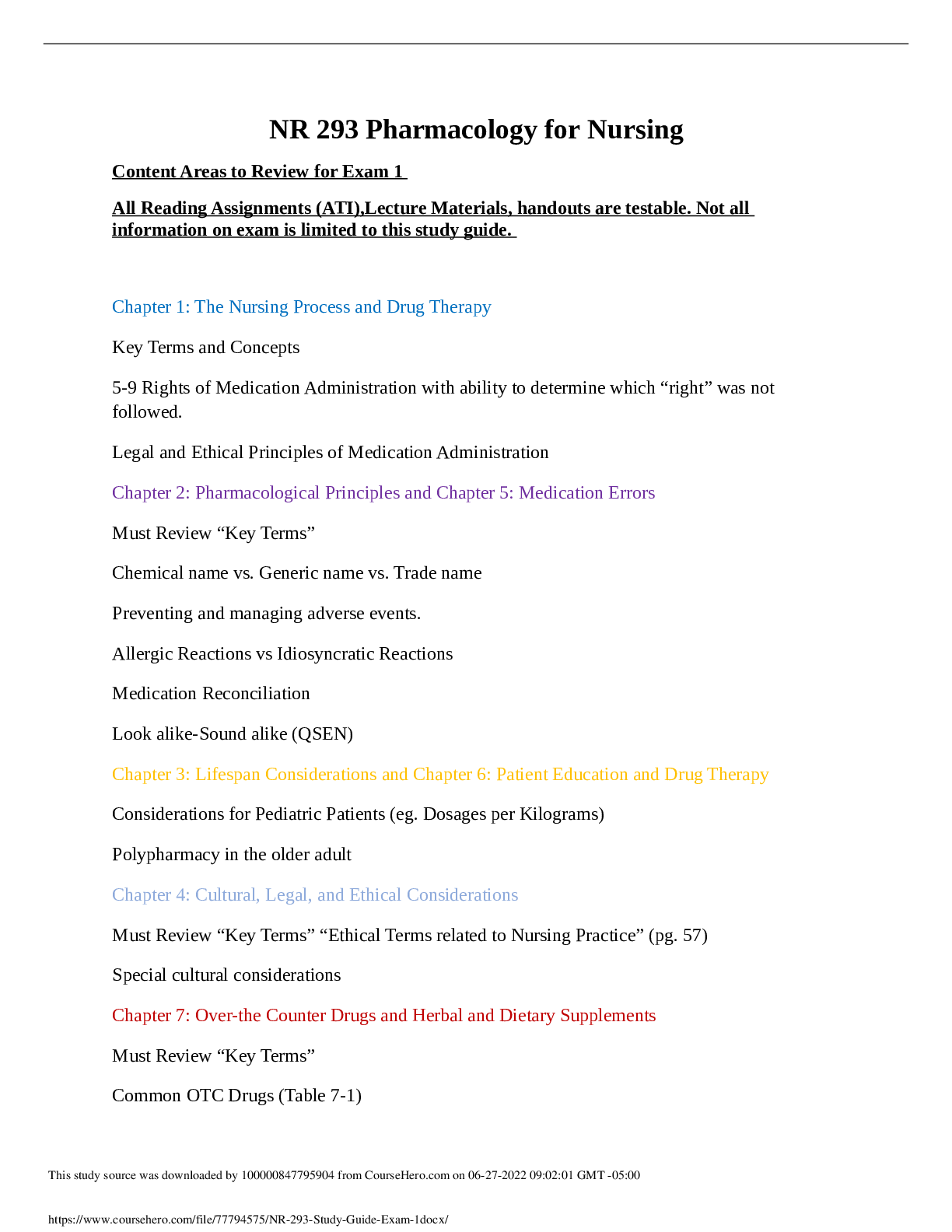



 Rasmussen College.png)
